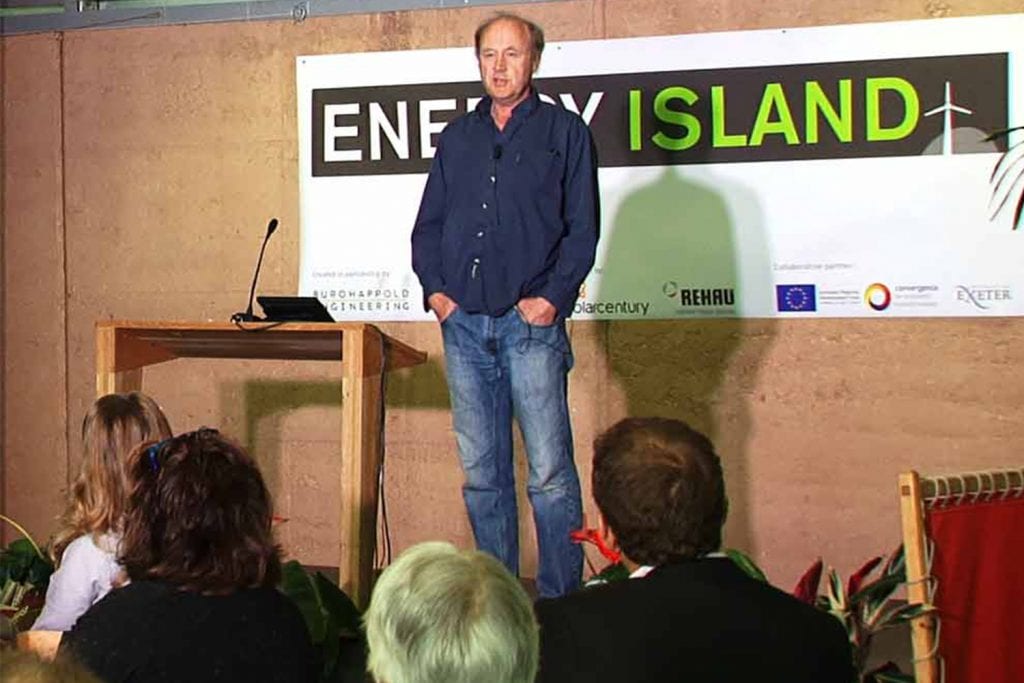To what extent can solar power help deliver a clean energy island in Cornwall?
In consideration of how far can we develop solar power in Cornwall to help to deliver a clean energy island, Sophie first considers the key challenges and early signs of hope

“Mummy did you build those ones? My son often asks me as we drive north along the A30 in Cornwall flanked by blue row upon row of solar PV panels on either side. The inland seas of blue are quite striking really. The solar scape reminds me of the train journey I used to do from Madrid to Seville when I was working in the Spanish solar industry in 2008. A similar thing happened there – the construction of these big blue farms suddenly came to a shuddering halt.
There have been some objections to the rapid proliferation of solar farms in Cornwall in the last few years. There’s not so much of the ‘not in my back yard’ sentiment that the onshore wind industry has suffered from, but there appears to be a ‘cumulative’ effect, that the view from the A30 might have provoked. The apparent density of solar power plants visible from the road, is largely due to the fact that the main distribution line runs along the same route as the dual carriageway, acting as a magnet to solar developers attracted to the lowest cost of grid connection, and in Cornwall – to some of the highest irradiance levels and hence project returns in the country.
The reality is that only 0.16% of Cornwall’s available land hosts these blue solar panels, and only 2% of ‘solar PV developable land resource[1]. To date, ~ 400MW of ground mounted solar farms have been built in Cornwall, and ~ 25MW of rooftop solar.
In theory there is enough viable land and roof space to host a further ~ 14GWp of additional solar capacity in Cornwall, but available space and tensions over the effect on the visual landscape aren’t really the key drivers. The limiting factors that will determine how much more solar will be developed in Cornwall are:
- Project economics – Can the project generate a sufficient return on investment – whether through subsidy or price parity with existing power supply?
- Is there availability of the grid at a reasonable connection cost, and can new generation be matched by consumption, exported or stored?
Project Economics
Last month, the government slashed the Feed In Tariff (FIT) by 65% for domestic solar. Even so, with industry costs continuing to come down, the domestic proposition should still yield a more attractive financial return than an ISA, given the right conditions (roof orientation, ease of access, self consumption level). And it is interesting that IKEA partnered with Solarcentury to re-boot a domestic offer across their stores this month, despite the inconvenient timing of the FIT reductions. IKEA cite research that 1 in 3 of their customers would like to invest in solar in order to reduce their energy bills by at least 50%, and the company promotes the solar panels as an essential part of the home.
The government has also just removed subsidies all together for large- scale (>1MWp) solar, so systems must compete on a ‘grid price parity’ level. In fact, there are already some utility scale solar systems being installed in other parts of the UK, where there are lower grid connection costs, and the numbers already stack up. For Cornwall, ‘grid price parity’ (£/kWh without subsidy) is likely to occur in 2019/2020 for larger systems.
Availability of Grid at a reasonable cost, ability to export or match supply with demand
Western Power Distribution (WPD), the region’s Direct Network Operator (DNO) recently told the renewables industry that it is closed for business (no new large- scale solar projects) for at least 5 years whilst grid reinforcement takes place. On sunny days in Cornwall, more power is produced than is used and pinch points along the lines stop the county from being able to effectively export the surplus to other parts of the country. This is obviously a tough pill to swallow for the South West renewables industry, which is why the social enterprise RegenSW is working so hard to lobby government to make the appropriate strategic investment in the grid.
You might think that such investments sound too difficult or expensive, but in a Climate Change Committee (CCC) recent report they estimate that you would only need to add £20 to a household fuel bill in 2025 to deal with the total cost of intermittency (spikey power availability) across the UK[2] should we power the whole of the UK from clean energy by 2030.
Locally, RegenSW are pulling key players together to innovate in the vital areas of:
- Energy Storage – both customer and supply side
- Demand Response – Influence consumer behaviour to better match demand with supply (put your wash on at midday).
- System operation management to find the most efficient decentralised model
Here in Cornwall, there are hopeful signs in all three of these areas, with local companies leading the way:
Energy Storage: On Cornwall’s South Coast, located in Falmouth University’s innovation centre at Penryn, the energy storage company Wattstor, are refining their IMP – Intelligent Power Management system. The IMP is a bit like the conductor of the orchestra, telling instruments (loads) when to come in e.g. heaters, lighting, appliances, pasty ovens, battery banks. The proposition is particularly attractive to their high-energy use commercial customers like St Austell Brewery and Trewithen Dairy Farm. They are also seeing a steady trickle of demand from early adopter homeowners for their domestic solar + energy storage kits, which unlike competitor solutions, allows grid resilience (the system continues in a power cut) as standard at an affordable price. With KPMG estimating that domestic level energy storage will take off in the UK in mid 2017, this Cornish company is well placed.
Demand Response: On Cornwall’s North Coast in Wadebridge, the ‘sunshine tariff’ was launched last month, via a collaboration of WREN (Wadebridge Renewable Energy Network), RegenSW, and Tempus Energy (a new kind of electricity supplier that uses algorithms and smart equipment to shift usage away from expensive times and into periods when prices are lower e.g. when renewable generation is very active). The aim of the Sunshine Tariff is to influence consumer behaviour to better match demand with supply, with a low 5p/kWh tariff incentivising customers to use power between 10am and 4pm. At other times they pay 18p/kWh. Customers are issued with smart controls to switch devices on and off at the most economic time.
System Operation Management: Western Power Distribution are leading calls for The National Grid and Ofgem to allow DNOs to switch to the role of DSOs (District system operators) with the ability to dynamically control generators and users of power to find the most efficient decentralised model. They suggest that local transmission charges (instead of national) would be one such game changer that a DSO could facilitate.
Conclusions
These small grass root projects are so important in demonstrating the possibilities of technology, new business models, positive behavioural change and strong consumer demand for localism and sustainable solutions that exist in Cornwall. If we have strong local leadership and a shared vision, together with continued global cost reduction in solar and storage technology, I forecast that an accelerated energy transition will pick up again in Cornwall from 2020.
In her next blog, Sophie explains why she believes solar PV is set to dominate the new energy landscape, and what it would take to power all of Cornwall’s domestic and industrial electricity needs from solar, stimulating at least 22,000 new local jobs.
References:
[1] Open, none designated land of low agricultural grade, at least 25m from residential area and < 2km from a 33kV network
[2] The cost is relative to investment in gas generation, and assumes a market price for Carbon. It would rise to £35 in 2030. https://www.theccc.org.uk/publication/power-sector-scenarios-for-the-fifth-carbon-budget/










